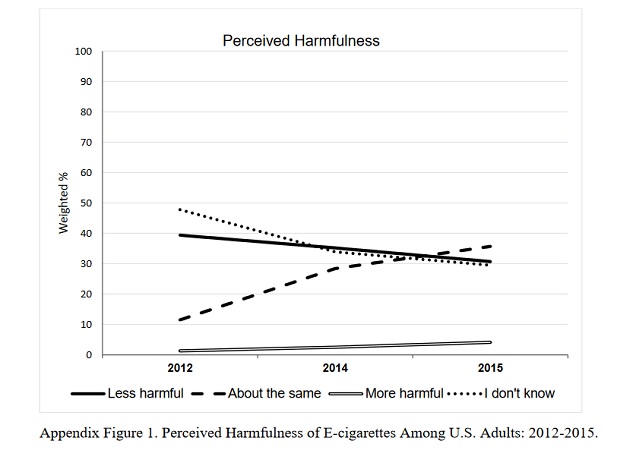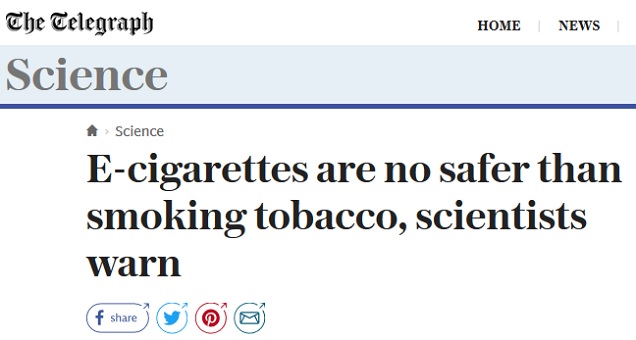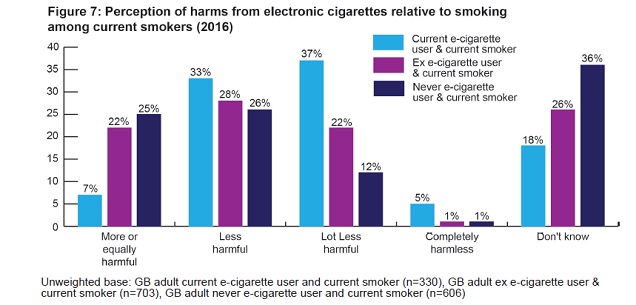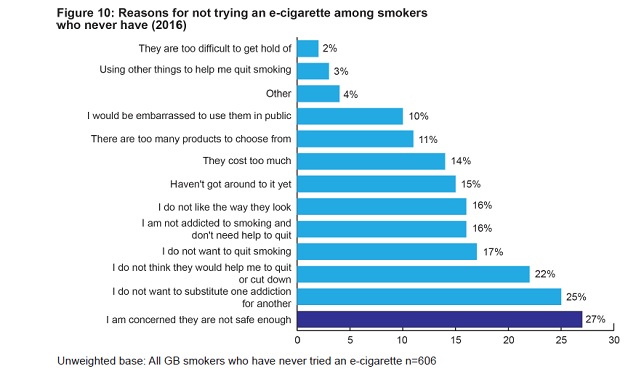
A study published in the March issue of the American Journal of Preventative Medicine shines the light on a genuine tragedy for public health. It shows how the communication of the scientific evidence on an important issue has been continuously distorted, and how those distortions can translate into real world harm. For anybody concerned about the well-being and health of the public, this should be a harsh reminder that a lot more needs to be done to serve the interests of the 15% of the US population that smokes. But as yet another study reveals how dangerously misinformed the general population is about the risks of e-cigarettes, the critics of vaping remain eerily silent about the growing problem.
The Study: How Dangerous Do American Adults Think Vaping Is?
The study is quite simple. Georgia State University’s School of Public Health conducted Tobacco Products and Risk Perceptions Surveys in 2012, 2014 and 2015. This asked questions about the risks of various tobacco products, including e-cigarettes, which had one question on their risk relative to smoking and another on their addictiveness.
The results are harrowing but not exactly surprising. Overall, the trend between 2012 and 2015 was for American adults – smokers and non-smokers alike – to become less and less accurate in their understanding of the risks of vaping.

In 2012, over 39% of Americans correctly identified e-cigarettes as less harmful than traditional cigarettes, with 48% saying they didn’t know, about 12% saying they’re just as bad as cigarettes and just over 1% saying they’re worse. By 2015, the number responding correctly had shrunk to just 31% and the number of uncertain respondents declined to about 30%. The real tragedy is that now 36 % of Americans think vaping is just as bad as smoking and 4% think it’s even worse.
The same trend is played out when you just focus on the smokers. In 2012, almost 45% of them answered correctly and about 40 % didn’t know, but by 2015, only 36% answered correctly, 29% were still uncertain, and the remaining 35% either thought vaping was just as bad as or worse than smoking.
As for addictiveness, the number responding that e-cigarettes are addictive increased from 32% in 2012 to about 68% in 2015. I’m honestly surprised that this hasn’t been higher all along, but in any case it’s a minor issue in comparison to the huge issues with people misunderstanding the risks of vaping.
The authors of the study clearly understand the state of the scientific evidence on vaping, writing in the conclusion:
There is an increase in the proportion of U.S. adults who misperceive the harm of e-cigarettes and consider them to be as harmful as combustible cigarettes. The study highlights the need to design public health messages that accurately interpret the scientific data on the potential harm of e-cigarettes and clearly differentiate the absolute from the relative harm of e-cigarettes.
Where the Misinformation Comes From
To avoid all doubt: vaping is much, much safer than smoking. While you may be able to cobble together something vaguely resembling an argument to the contrary with enough cherry-picking, this point is becoming increasingly impossible to ignore.
Even Simon Chapman, one of the most prominent critics of e-cigarettes, has written that “No one sensible makes the argument that e-cigarettes are likely be even remotely as harmful as smoking.” Stanton Glantz agrees with this. The Surgeon General agrees with this (page 203 to 204 of the PDF). Everybody who wants to have a rational conversation about e-cigarettes has to accept this.
So the real question is where does the misinformation come from?
Misleading Media Coverage of E-Cigarette Studies

The authors first point to misleading media stories, with a particularly egregious example from Sarah Knapton at the Daily Telegraph in the UK cited in the study. This isn’t news to anybody who’s been following the vaping debate over the years: a shoddy study is published, an even worse press release is put out and then lazy and/or biased journalists repeat claims in the press release verbatim, potentially embellishing the results a little more for the sake of a snappier headline and a few more clicks. This is business as usual.
Focusing on Absolute Risk, Rather than Relative Risk
The authors give several examples of studies the media blew out of proportion, but importantly draw attention to “framing bias” and how it affects our understanding of risk. They argue that by focusing on the absolute risks of vaping (which do exist, because pretty much nothing is completely and utterly safe) instead of relative risk compared to smoking, the media is driving this misunderstanding.
The authors use other examples, but a great one is diacetyl. Studies finding that some e-liquids contain potentially dangerous levels of diacetyl are presented as if it’s a risk unique to vaping, with the unfamiliar condition “popcorn lung” being the perfect way to cement this perception.
However, it is rarely ever reported that cigarettes contain vastly more diacetyl than e-liquids – anything from 100 to 250 times more. Presented as “e-cigarettes contain flavorings that are harmful to inhale,” this may make smokers think vaping is just as bad as smoking, but presented as levels relative to smoking, it would become abundantly clear that vaping is the safer choice. For people to get an accurate perception of the risk of vaping, it must be put into context.
Negative Portrayals of Vaping in General
They also point out that even an attempt to objectively explain what a study found can be impacted by the overall tone and image of the reporting. If e-cigarettes are painted as a looming threat – even while you’re explaining evidence showing they aren’t so bad – people will see them as a threat.
Disproportionately Focusing on Rare Accidents
Another possible source of misunderstanding is the perverse focus on rare accidents related to vaping. If somebody falls asleep with a cigarette and burns his house down, it’s unlikely to be seen anywhere apart from a local news outlet with nothing better to cover. E-cigarette explosions, on the other hand, are much rarer than cigarette-related fires, but almost certain to make headlines. Add in some gruesome pictures and misleading statements about absolute risk with no mention of relative risks and it’s the perfect storm.
Stories about e-liquid poisonings follow the same formula and have the same effect. Do you ever recall seeing a mention of how many kids are poisoned by eating cigarettes in media stories about how e-juice is “liquid poison”? Neither do I. But as it happens, that’s a much bigger problem.
Won’t Somebody Please Think of the Children?!
Finally, the authors point out that the “think of the children!” narrative may be having a role to play too. While these stories often don’t say anything explicitly about the risks or benefits for adult smokers, the broadly negative portrayal and the eagerness to draw comparisons with the tobacco industry’s past can easily lead to the idea that e-cigarettes are “just the latest incarnation” of the same deadly product.
None of this should be a surprise, but the important thing is that this study – like others in the UK – makes the issue explicitly clear. If you write a misleading story for a media outlet about e-cigarettes, you are directly contributing to a growing misunderstanding on a topic that could directly impact somebody’s life. A real, living human being could make a decision on the basis of your coverage or the things you omit to cover. Somebody choosing between something really bad for you and something over 20 times less bad for you might end up sticking with the really bad one just because you didn’t respect them enough to tell the goddamn truth.
The Damage Done by Anti-Vaping Misinformation

This is the point where vaping advocates – myself included – often make some moderately-hysterical suggestion that misinformation is “killing smokers” or something along those lines. Of course, this ignores the very clear fact that what’s killing smokers is smoking. Unless the biased and/or misinformed journalists, anti-vaping activists and researchers are personally going around to people’s houses and forcing them to smoke, they are not “killing smokers.”
But there is a kernel of truth in there. As the authors of the study point out, studies have shown that people who understand the relative risks of smoking and vaping are more likely to try and currently use e-cigarettes. Smokers trying to switch who know that e-cigarettes are less dangerous than combustible cigarettes are more likely to completely switch. This is established by studies like this, this, this and this, if you want more detail, but it inherently makes sense anyway. If you think something is less dangerous, you’re more likely to do it than someone who thinks it’s more dangerous.
Data from ASH UK lets us put some clearer numbers on these concerns. Smokers who’ve never vaped are the most likely to believe that vaping is more harmful or just as harmful as smoking, and by far the most likely to not be sure. Over a quarter of them said that they hadn’t tried an e-cigarette because they were concerned about the risks, and this was the most common reason given. Out of the smokers who’d already tried vaping but didn't currently vape, 16% said they would try it again if they had confidence they were safe to use.

This is when the high percentage of smokers believing that vaping is as bad as smoking takes on a disturbing significance. That rising number of smokers who believe vaping is just as bad as smoking or worse – from about 12% in 2012 to 35% in 2015 – really means a rising number of people who are now less likely to reduce the harm from their nicotine addiction. Distorting their understanding of the relative risks of vaping and smoking does nothing to help them stop using nicotine, of course, it just increases the chance they’ll continue to use it in the most harmful way possible. Everybody should see that statistic as deeply disturbing.
Can We Stop the Misinformation?
The bad news from the ASH UK survey is that the situation isn’t much better in the UK, where most public health messages about vaping are positive. In 2013, 7% of adults thought vaping is just as bad as or worse than smoking, but this rose to 25% by 2016. This is better than in the US (where it was 36% in 2015), but the number who say they’re less harmful or a lot less harmful is still under half.
This shows that trusted organizations can make a difference, but it ultimately seems like the media is the problem. Public Health England and the Royal College of Physicians can back vaping publicly and pretty emphatically, but some journalist hunting for a scare-story will still occasionally come across a press release that gives them just what they’re looking for. And when this is the attitude journalists have to the topic:

We have a big problem.
Stopping this doesn’t seem easy. Gerry Stimson and others challenged the very headline referenced by the study’s authors – “e-cigarettes are no safer than smoking tobacco, scientists warn” – but weren’t successful (more about this on Clive Bates’ blog here). The study the article was about showed no such thing, and the scientist who made that claim was clearly going above and beyond the data, but this was brushed aside and the headline still stands today, waiting to mislead more smokers.
In the US, the Surgeon General had the perfect opportunity to make a Public Health England-like dent in the misunderstanding of the risk of vaping, but he passed it up. The CDC is on a crusade against the hugely exaggerated problem of youth vaping, fixed on it so strongly that they barely seem to consider smokers. And the FDA is basically destroying the industry. Throw in the media, local departments of public health and fanatic anti-smoking groups and it all looks a bit hopeless.
So what can we do? Unfortunately I have no answers. The only thing that makes sense is to keep challenging misinformation – as politely as possible – and hope that people open-minded enough to look at the facts will come around. But what we really need is for people in positions of influence to start standing up for smokers. We need those in public health who genuinely care about public health to come out and speak about results like this. We need compassion for smokers, we need pragmatism and we need people willing to stand up for the truth in this decidedly post-truth age.
But all too often, what we get is more misleading articles, more poorly-designed studies and very little visible concern about results like this from anybody who isn’t openly pro-vaping. Advocates can keep fighting, but until more influential, “mainstream” figures who can't be easily brushed aside as “shills” or “astroturf” start to stand up to misinformation and endorse vaping as safer than smoking, I fear we’re fighting a losing battle.
At the moment, the silence from tobacco control and the US public health establishment is deafening.

